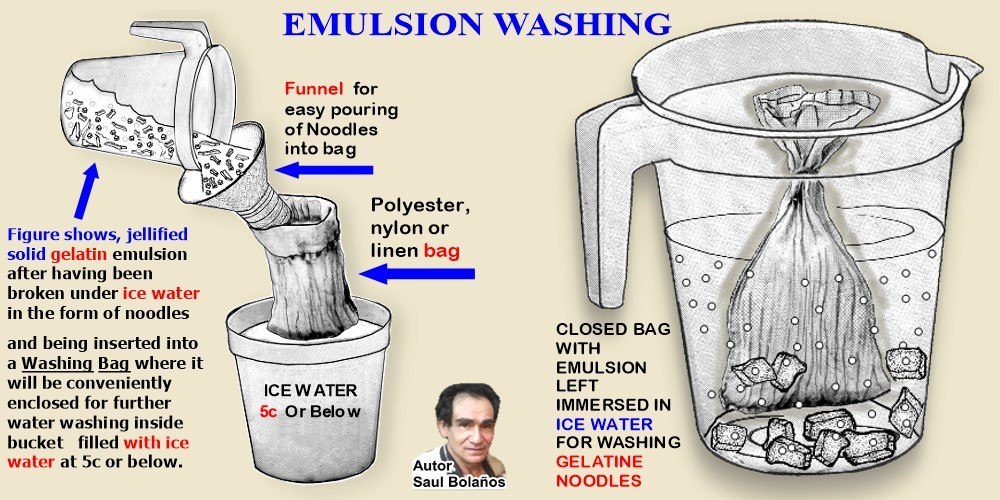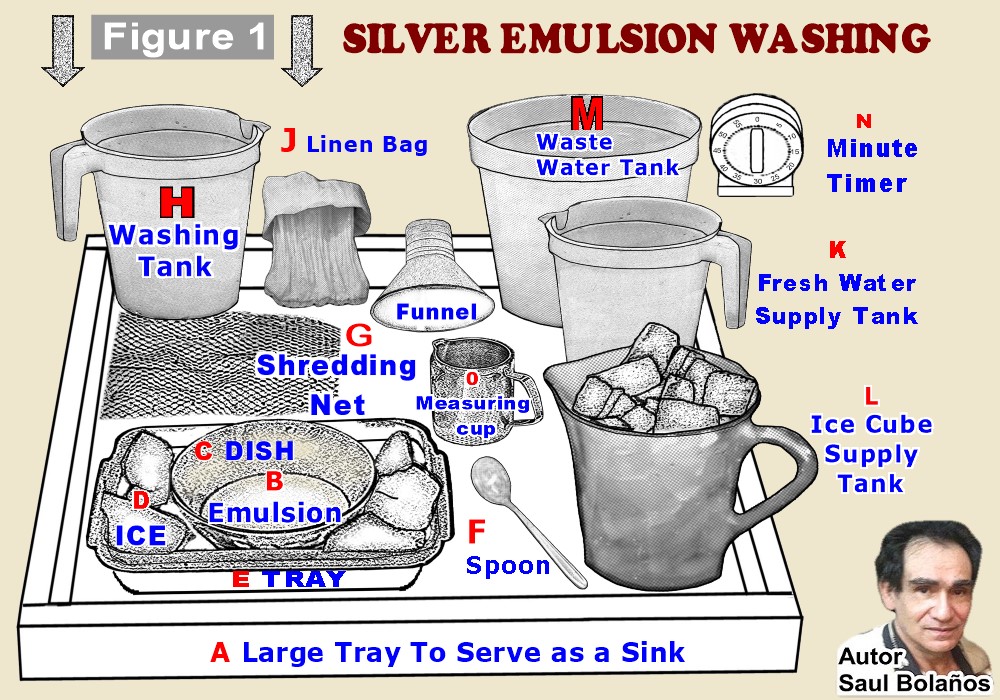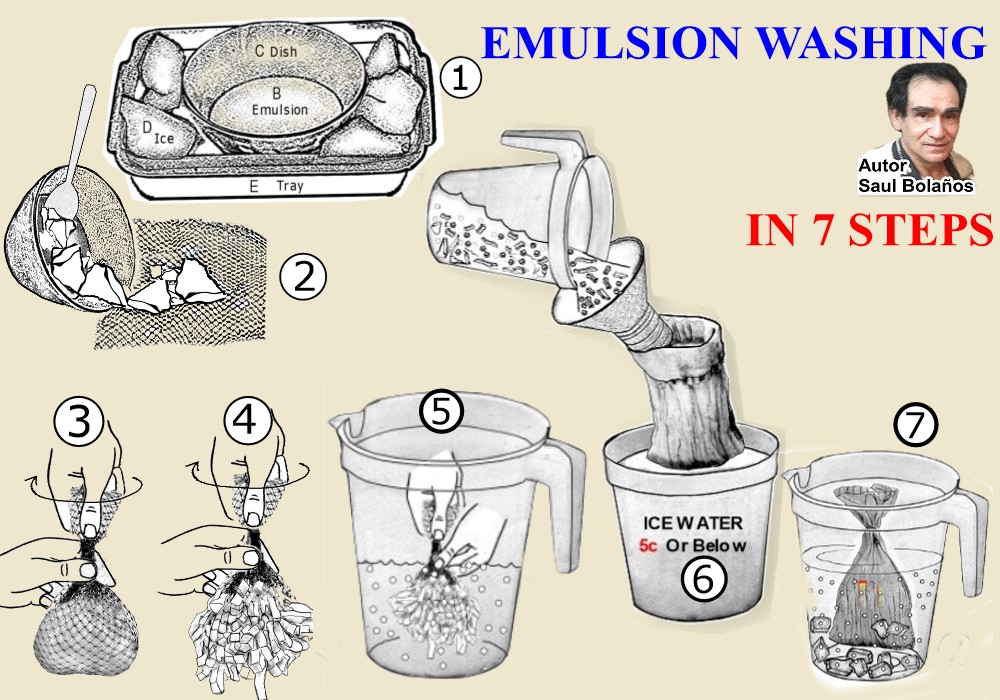CHAPTER 4
WASHING OF SILVER GELATINE EMULSION
Washing gelatine silver photographic emulsion is given here in my Ebook: chapter 4, describes washing of silver
bromide and silver chloride gelatine silver emulsions. liquid light sensitive silver emulsion are delt with in this
ebook of saul bolanos: PHOTOGRAPHIC SILVER EMULSIONS BOOK.WASHING GELATINE SILVER PHOTOGRAPHIC EMULSIONS STEP BY STEP GENERAL PRINCIPLES
APPLIES TO ALL EMULSIONS Ammonia and Non Amoniacal Emulsions As well as Positive or Negative Emulsions
---------------------------------------------------------------
Some positive emulsions do not need to be washed. For any particular Emulsion see its specific Graphic and Textual Directions if Any. Washing is performed immediately after emulsion mixing (precipitation) at the end of the First Ripening.
WHY EMULSIONS ARE WASHED
After Precipitation and first ripening (if any) the white milky emulsion will have in its composition two types of ingredients. “Soluble “which will wash out and “insoluble” which will not wash out.
INSOLUBLE INGREDIENTS
A) -Silver bromide B) - silver iodide c) -Gelatine
gelatine is the vehicle of the insoluble silver salts which is insoluble in cold ice water (but soluble above 26c 29c (79 – 84 f) The gelatin and its suspended silver salts being insoluble will remain in the shredded solid emulsion during the washing with ice water, to form the useful emulsion.
SOLUBLE INGREDIENTS
These will all diffuse out of gel if given enough time during the washing, these are:
a) Ammonia, if left in the emulsion it would give rise to all kinds of brown, yellow, orange, and gray fog and stains during alkaline development.
b) Potassium nitrate if left in emulsion when coated on impervious supports like glass, plastics or ceramic tiles; would crystallize on the coating on drying; giving marks and spots. It will also delay setting of the gelatine.
c) Potassium (or ammonium) Bromide The unused soluble bromide (that was left necessarily in excess) that did not react with the silver nitrate to form insoluble silver bromide. The great bulk of this soluble or “free bromide” if not washed out would prevent the silver salts from absorbing the natural sensitizers present in the gelatin, another words they would retard second ripening enormously. The direct cause of this will be an emulsion with a considerable lower speed and contrast.
On the other hand, if absolutely all of the “free” potassium bromide is washed out, the chances of fog ensuing due to the “silver” being now the dominant ion in the emulsion, are extremely high. Further more due to the fact that the free soluble potassium bromide washes out at a much faster rate than the soluble ammonia;
 Prolonged Washing
Prolonged Washingmay leave in fact the silver ion as dominant. To prevent this, some free soluble potassium bromide is added to the washing water (see further below) in this way, it does not matter how long the emulsion is washed, and there will always be some free bromide which will prevent the silver from going dominant. To ensure even more, that there is sufficient free bromide in the emulsion after washing before submitting to a Second Ripening. free bromide is added as ANTIFOGANT in some formulas. For example solution D in Ammoniacal emulsion formula # 1 This quantity should not be increased otherwise ripening will take too long and contrast will be lower.
As STABILIZER its quantity is increased however at the end of second ripening; (in the “finals” solution E) but only when the emulsion has already absorbed sensitizers from the gelatine and attained great light sensitivity and contrast. This increased quantity of free bromide as STABILIZER will arrest further ripening of the emulsion at 50c (122f) and enormously at lower temperatures.
Once the emulsion has been coated and has lost its humidity, on drying on its support; the free bromide will prevent fog ensuing on the dried coated material for more than a year if stored at room temperatures 20 – 26c ( 68 - 80 f ) and many years if stored sealed inside light proof bags with as little air as possible under refrigeration at 5 c (41 f ) or below. Emulsion to be kept and sold in humid form need more powerful stabilizers or antifogants.
Positive Emulsions formulated without ammonia or types that are not too rapid and are to be coated on absorbent supports like fiber paper, wood, cloth, etc. do not need to be washed. The soluble salts will leach or sink into the substrate or material. Some unwashed Positive Chloride and Chloro-bromide emulsion formulas are given in this book. They are easy to make
 WASHING
EMULSIONS REFER TO F I G U R E 1 Step By Step. Wash Under Red Safe Light
illumination. in Fig 1, is shown all you need to wash 250 – 500 ml of Emulsions
intelligently. SUMMARY OF STEPS:
WASHING
EMULSIONS REFER TO F I G U R E 1 Step By Step. Wash Under Red Safe Light
illumination. in Fig 1, is shown all you need to wash 250 – 500 ml of Emulsions
intelligently. SUMMARY OF STEPS:
Emulsion B in dish C is set into a jelly in tray E, cooled with ice cubes D, set emulsion is scraped off dish C, with spoon F, onto the shredding net
G, which is then gathered into a ball and twisted so as to force the stiff emulsion through the mesh opening
forming shreds or noodles.
This is done under ice water in washing tank H. The noodles or emulsion shreds are then
inserted into the linen bag J, by means of wide mouth funnel the emulsion enclosed in the
linen bag J, is now suspended or immer-sed in washing tank H
for washing, drawing clean ice water from fresh water supply tank K,
After of about 5 minutes washing the spent water is dumped in waste water tank M. To cool the washing water, ice cubes are taken from ice cube supply tank
L, the amount of water is measured with measuring cup o and the washing time is controlled with minute timer N., This tank H, will also serve as the emulsion
washing tank in the following manner: When 2 liters of fresh ice water ( which may be drawn from with measuring cup O) taken from fresh water supply tank K, are added to
washing tank H, tank H will be half full then and this will be enough water to cover the
emulsion bag (step 7 way below) if not, more fresh water may be added from fresh water
supply tank K, until there is enough water to cover the bag containing the emulsion.
At the end of about every 5 minutes of having immersed (with frequent agitation) the
emulsion bag inside the ice water in washing tank H, the water is ready to be changed, to
effect this, the used water is dumped in waste water tank M, then another 2 liters of new
water is drawn from fresh water supply tank K, after another 5 minutes, the cycle is
repeated again dumping the used water and replenishing with Fresh one from fresh water supply
tank K.
K, is a about a 4 liters capacity jar filled with clean water
to wash the emulsion. Since it does not contain all of the quantity of water required for washing the emulsion, it
will have to be refilled from time to time with fresh water to replace the water used during the course of the
emulsion washing. The clean water supply in tank K has to be continually cooled by
drawing ice from ice cube supply tank L which is an ice cube supply tank to keep adding
to fresh water supply K, to keep its fresh water cooled to the point of melting ice, (to
5c / 41 f or below) otherwise the emulsion jelly will absorb too much water.
(especially with room temperature above 25c) no need to measure the temperature of the fresh water supply tank; as
long as there is un melted ice cubes floating in the water because in such case the temperature will be 5c ( 41 f )
or below. The colder the better. Ice must also be added from time to time to water of washing
tank H, to keep its water cool this is of the utmost importance M, is the waste water
tank, where the spent or used emulsion water is emptied. It may be about 8 liters capacity (2 gallons) after
each 5 minutes or so of washing emulsion with fresh water in washing tank H, the spent
water is thrown or discarded in this waste water tank M, Since It fills up quickly,
(especially with ammonia emulsion which require much longer washing) when it does, it has to be emptied by dumping
its contents down the drain or sink. N, is a minute timer
which is set to ring the bell every 5 minutes to signal the beginning of a new change of fresh washing
water.

MORE ON EMULSION WASHING
Refer To “ Emulsion Washing in 7 steps ABOVE “
(See Step 1 above) The time the emulsion
is let in the ice tray E, is usually about 30 minutes (with room temperature 20-25c) or until it has set into a stiff
jelly, when as firm as a hard rubber ball, (fig 2 ABOVE) with
stainless steel spoon with gelatine now set emulsion is placed onto the shredding net and it is shredded by forcing
it to pass through the openings of the net (fig 3 - 4 )
This emulsion shredding step (so shreds do not stick together) is done inside washing
tank Step 5 , previously filled with enough ice water. This
tank should have a capacity of about 4 liters (1 gallon) with a wide mouth to immerse
both hands comfortably to shred emulsion... (Step 5 ) ,After
shredding emulsion is enclosed inside linen bag for washing: STEP 6 and the bag with the emulsion noodles immersed in ice water to wash,STEP
7. EMULSION WASHING IN 7 STEPS. Emulsion
Washing Data for 250 to 500 ml of Emulsion Full Ammoniacal emulsions require at least 12 changes
of water with frequent agitation while neutral non Ammoniacal emulsions can be washed with 4 - 6 changes. The amount
of ice needed depends on room temperature, if above 25c more ice, if below 22c, less is needed. Since the free
bromide in the emulsion washes out faster than the ammonia, the silver may end up in excess of the bromide causing
fog on alkaline development. To avoid this fog due to over washing; -add the free bromide (as given below ) to the
washing water, for ammonia emulsions only (with experience even less than half the amount of washing water given in
table below can be used; - this is important for economy when washing with distilled or rain water on localities
where the tap water has too much calcium or magnesium)
 IN TABLE
ABOVE
IN TABLE
ABOVE
Fig 2 The size of the washing bag J, shown above, for a more effective washing should be large enough to accommodate all of the emulsion noodles
or worms, plus 2 – 3 times the emulsion volume in free space. In this way there will be enough free space inside the
bag to move the emulsion around during washing. Thin Linen fabric the type used to make bed sheets or handkerchiefs
is adequate (cotton is too heavy and absorbs too much water) synthetic fabrics absorb less water and are excellent as
long as the fabric is thin and finely knitted. For 250 – 500 ml of emulsion, a bag size
15 x30 cm (6 x 12 in) is fine.
Fig 3 Shredding Net G, above shown is a
section of a polyester net used for shredding the chilled and set emulsion. These nets are used for packing fruits
and vegetables. Net above came enclosing 1 kilo of carrots. Mesh openings shown are about
7 mm wide but can be a little smaller or larger. A net size 20 x 25cm (8x10 in) for
shredding 250 – 500 ml emulsion works fine, the larger the better. If the whole volume of the jellified emulsion can
not be shredded all at once, It can be shredded in portions scraping it off the emulsion dish in amounts that will
fit well on the size of the net used and that can be shredded comfortably under the ice water, so fragments will not
stick together.
TEXT MESSAGES
IN
COSTA RICA
6012 4695
![]()
CONTACT

COSTA RICA © 2025, saul bolaños
CAFEDESAUL@GMAIL.COM